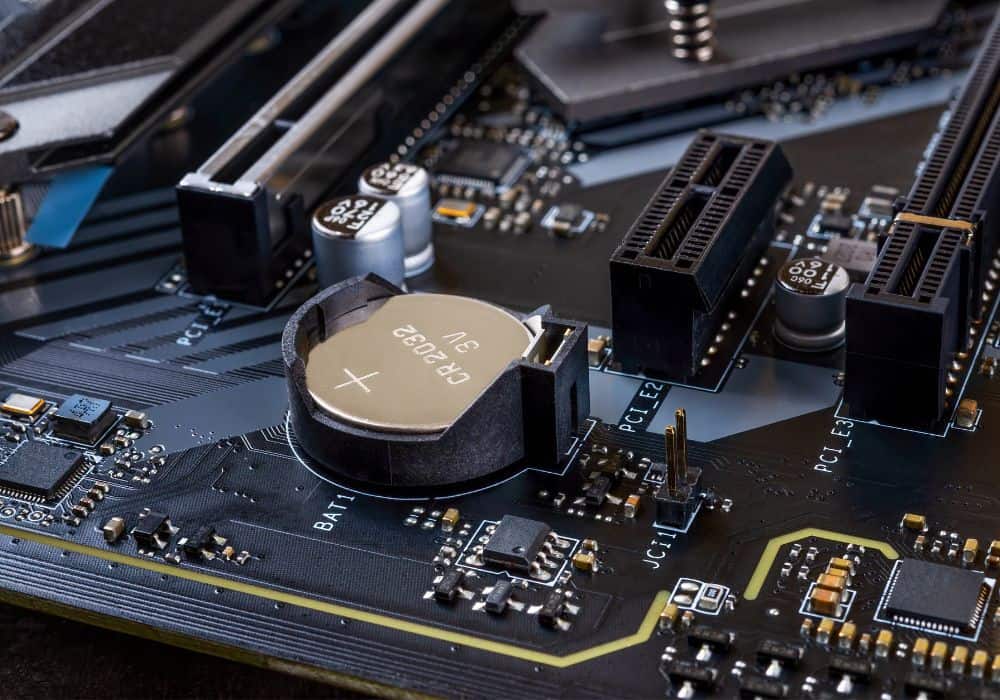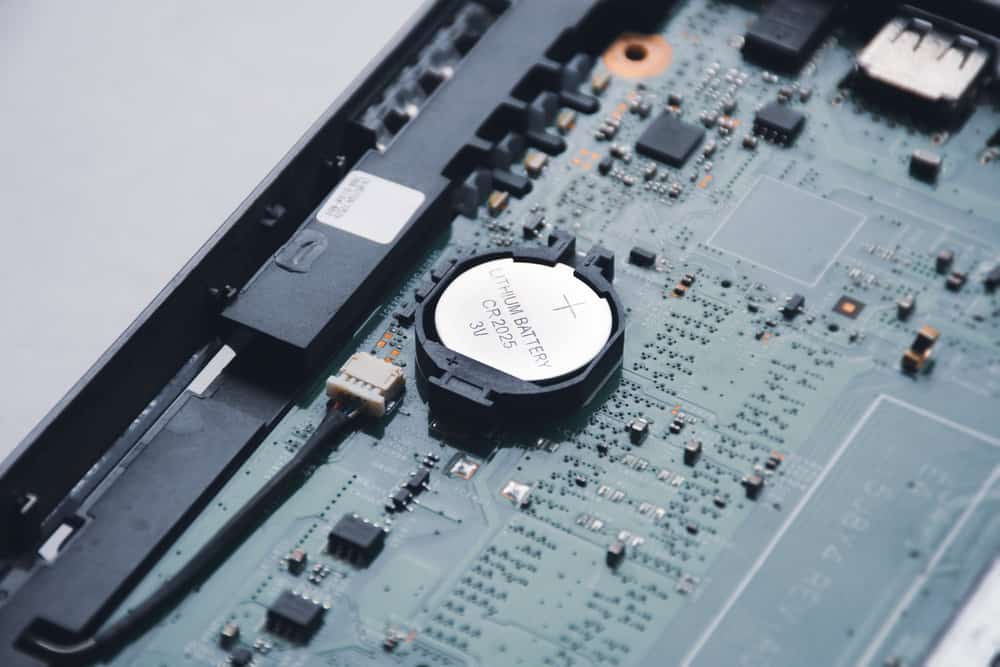Your computer is a complex machine with many different components that work together to allow you to browse the internet, write papers, and check Facebook. One of the key components in your computer is the CMOS battery.
This little battery helps keep your computer running by providing power to the CMOS (complementary metal-oxide-semiconductor) chip.
So, if you are wondering: What does the CMOS battery do? You are in the right place. In this blog post, we’ll take a look.
Table of Contents
What a CMOS batter is, and what it does
A CMOS battery, also known as a real-time clock (RTC), non-volatile RAM (NVRAM), or CMOS RAM is found in both desktop computers and laptop computers, although they are typically only found in laptops.
The CMOS chip is a small battery typically used to keep system time and clock settings and other important hardware settings and information stored in the CMOS memory of your computer, as well as what is responsible for allowing you to still use your computer even when it isn’t plugged in.
It is typically located near the CPU or motherboard, in an area where it can be easily accessed by the user. Due to its essential function, CMOS batteries must be maintained and replaced periodically in order to ensure optimal performance from your device.
Your CMOS charges when your computer is plugged into its power source.
If you notice any signs of wear or damage to the battery, or if it stops working properly, it is important to replace the battery immediately in order to avoid any negative impact on your computer’s performance.
How long does the CMOS battery last?
In general, a CMOS battery will last anywhere from 2-10 years, though this will depend on a number of different factors, including how often you use your computer and the type of power settings that you have in place.
If you want to extend the life of your CMOS battery, it is important to keep your computer equipment clean and free from dust buildup, as this can damage the connections between the computer’s system board and the battery itself.
What will happen if the CMOS battery is removed?

If a CMOS battery is removed from a device, several consequences can be expected.
First and foremost, the date and time settings of the device will be lost.
In addition, any other custom settings that are saved to the battery, such as screen brightness, sound volume levels, and boot-up preferences, may be lost as well.
Moreover, if the device is not restarted within a certain period of time after the battery is removed, it may become permanently inoperable.
Depending on the type of device and its programming, the consequences of removing this battery can range from mildly inconvenient to completely disastrous.
Therefore, it is important to be aware of this risk when working with electronic devices or handing over your old devices for recycling or repair.
What is the voltage of the CMOS battery?
The voltage of a CMOS battery, also known as a backup battery, is typically 3 volts. This low voltage is necessary in order to power the memory and keep it protected during times when the computer is in standby or hibernate mode.
In addition, the low voltage helps to ensure that the battery has a long life span, making it an important component of any computer system.
Other factors that impact CMOS battery voltage include current draw, temperature, and output capacity.
Ultimately, the specific voltage for any given CMOS battery will depend on its design and quality.
But regardless of specific details, it is clear that this small but vital component plays an integral role in ensuring that our computers continue to run smoothly no matter what.
How to know if your CMOS battery is failing

There are certain signs that can indicate when your CMOS battery is starting to fail.
If your computer has a hard time booting on startup or even fails to start up at all, this is one of the biggest indicators of a failing CMOS battery.
Along with issues starting, there are also some other issues that can signal your laptop has a failed battery.
- You hear a persistent beeping sound coming from the motherboard
- You have to set the date and time every time you power on your PC
- Your peripherals don’t respond accurately
- You can’t find your hardware drivers
- You have connectivity issues
- You are receiving a CMOS Read Error
- You are receiving a CMOS Checksum Error
- You are receiving CMOS Battery Failure
- You are receiving a message that the system battery voltage is low
How to change a CMOS battery

If your computer is having the issues listed above, it might be time to replace your CMOS battery. Luckily, it’s a pretty easy process, and you only need a few tools.
Step 1: Have a clean workspace
The first step to changing your CMOS battery has a clean and organized workspace. Also, ensure you are on a hard surface as opposed to a carpet or rug to reduce electrostatic discharge.
Before you get started, make sure you have plenty of room so that you can move around freely. This will help minimize the risk of accidentally damaging any components or cables as you work.
Step 2: Disconnecting cables
Next, be sure to disconnect all power sources from your computer before beginning the process in order to avoid any accidental electrical shocks or other hazards.
With a clear workspace and all cords disconnected, you can begin taking apart your computer and replacing the old battery with a new one.
Step 3: Remove the casing
The first step in changing your CMOS battery is to remove the casing from your computer. This can usually be done by unscrewing a few bolts and releasing any clips holding the casing in place.
Step 4: Remove the main battery
Once the casing has been removed, you should easily access the main. This is a long rectangle-shaped battery. You want to remove this so your computer doesn’t turn on while you are working on it.
Step 5: Remove the CMOS battery
To change your CMOS battery, the first step is to remove it from your computer. This can be done by carefully removing the battery from its housing on the motherboard.
It’s important to be very careful when handling the motherboard, as it is one of the most critical components in your computer, and any damage could cause irreparable problems.
The round, shiny battery in your laptop is the CMOS. It looks just like a button or coin and usually slides into the socket with ease!
Step 6: Replace the CMOS battery with the new one
Next, you need to replace the old battery with the new one. Make sure you refer to your owner’s manual to make sure you are replacing the battery accurately for your specific computer.
Positioning the new battery correctly can help to ensure that your computer functions properly after the change has been made.
Once you’ve finished replacing the battery, simply reattach the battery cover and reconnect any wires that had been disconnected during the process.
What type of CMOS battery do I need?
When it comes to choosing the right type of CMOS battery for your device, there are several factors that you will need to consider.
First, be sure to check your laptop’s manual to check to see what type of CMOS your laptop needs. If you don’t have the manual, try looking up your laptop’s serial number located on the sticker, and you can research what kind of battery you need.
Another important factor is the type and quality of the battery that you choose. Low-quality batteries may not last as long or function as well as more expensive models, so it is important to do your research and find a reliable brand that fits your needs.
Ultimately, finding the right CMOS battery for your device requires some careful consideration and planning, but with some time and effort, you can be sure to get the perfect model for your needs.
Conclusion
So there you have it! Overall, a CMOS battery plays a vital role in helping your computer function at its best.
Hopefully, this article was helpful in explaining what this important little battery is and why it’s so crucial to your computer’s health.
If you found this article helpful, please let us know in the comments! And don’t forget to share with your friends and family who might also be curious about what CMOS battery does.
